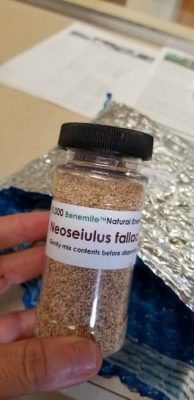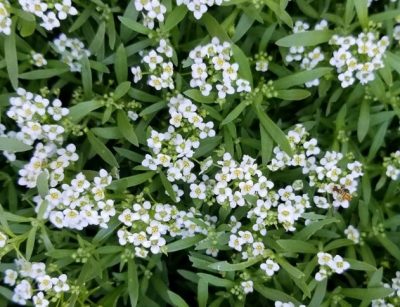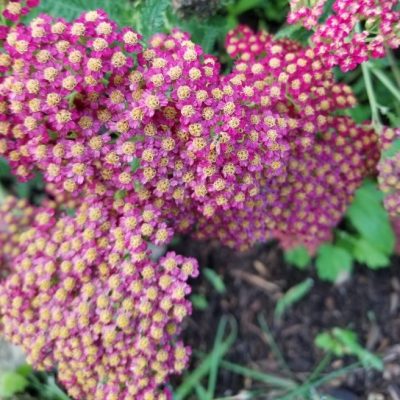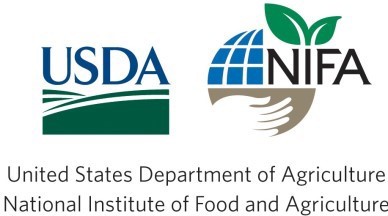By Vickie Wallace, John Inguagiato, and Alyssa Siegel-Miles, UConn Extension
Public and private K-8 school grounds and athletic field managers have been managing school grounds utilizing Integrated Pest Management (IPM) protocol for many years. Since 2010, use of IPM has become even more important to school grounds managers as state legislation has limited the products available for use on K-8 school grounds and athletic fields (Connecticut General Assembly, 2009). Amendments to the law in 2015 allowed the use of microbial or biochemical pesticides on K-8 school grounds, expanding the tools available for school grounds managers. Biological pest control (BPC) is gaining increased interest as a component of grounds management programs to control insect pests, diseases, and invasive plants in the school landscape. However, successful use of existing biocontrol products and strategies are variable; with greater efficacy currently achieved within certain target pest groups.
Biocontrol has been used widely in agricultural crop management, especially in greenhouses. Pest control services provided to agriculture using beneficial insects are worth roughly 13.6 billion dollars annually (Losey, Vaughn, 2006). More serious attention has been devoted to landscape and turf biocontrol applications in recent years, as BPC has become more successful and more products have become available.
WHAT IS BIOLOGICAL PEST CONTROL?
- Biological pest control (BPC) is an IPM practice that uses living organisms to control and reduce populations of undesirable pests. These living organisms can be bacteria, fungi, or predatory or parasitic agents (e.g., insects, nematodes).
- Biopesticides, which are derived from living organisms, are an alternative to (organic or synthetic) pesticides and are usually more target/host-specific than conventional/chemical pesticides. Microbial pesticides include microbes (e.g., bacteria, fungi). Biochemical pesticides include natural substances (e.g., insect hormones) that repel insects or cause mating disruption.
- BPC also includes the practice of releasing, spraying/drenching, or attracting biocontrol agents (predators, parasitoids) that seek out and consume insects, mites, and plants that are considered pests.
ADVANTAGES OF BIOLOGICAL PEST CONTROL:
- Reduces the pest population and their impacts on the environment.
- Environmentally friendly: inherently less toxic to humans and the environment; do not leave harmful residues.
- Reestablish the natural balance of nature. Biocontrol does not completely eradicate pests; it keeps them at lower threshold levels, with the objective to keep pest levels low enough to maintain healthy landscapes and safe playing fields on school properties.

ESSENTIAL ELEMENTS OF A SUCCESSFUL BIOCONTROL PROGRAM:
- Routine scouting: UConn’s Athletic Field Assessment Form and Landscape Assessment Form are useful tools (find at ipm.cahnr.uconn.edu).
- Accurate identification of pests, diseases, and beneficials.
- Sufficient planning and timely implementation.
Using BPC requires that attention is paid to the lifecycle of both the biocontrol agent and the pest. Sufficient time for the lifecycle of the biocontrol agent and for the production of a living organism must be considered when planning a control strategy. In some cases biological pest control programs fail due to a lack of planning or delays in implementation. Often, there is a limited window to order these living organisms. For example, some biocontrol products, such as insect pathogenic nematodes, must be ordered by early August in order to be received in time to apply in the third week of August. This can pose a challenge for the timing of school properties as school grounds managers prepare for the new school year. Weather also influences pest lifecycles, further complicating planning and optimal application timing.
BIOLOGICAL PEST CONTROL IN TURFGRASS
Biological control agents used for turfgrass pest management include products containing bacteria, fungi, and nematodes. Examples of BPC agents used on turfgrass pests are Bacillus thuringiensis var. galleriae, a bacterium that controls white grub species; turfgrass cultivars containing endophytic fungi that deter leaf- and stem-feeding insects; and beneficial parasitic nematodes for insect control. Various products are currently available and offer some level of control against turf pests in lieu of synthetic pesticides. However, practitioners should be aware that the efficacy many biological control products currently available in turf is inconsistent at best. Research is ongoing to optimize application strategies of these products to achieve better and more consistent control.
Table 1. Selection of microbial biopesticides currently labeled for control of insect or diseases of turfgrass.
| TRADE NAMES | ACTIVE INGREDIENT | LABELED PEST TARGETS |
| Nemasys; NemaShield | Steinernema feltiae (nematode) | White grubs |
| grubGONE; beetleGONE | Bacillus thuringiensis var. galleriae (bacteria) | White grubs |
| Grandevo PTO | Chromobacterium subtsugae (bacteria) | Armyworm, cutworm, sod webworm, chinch bugs, grubs (masked chaffer, oriental beetle) |
| Companion | Bacillus subtilis GB03 (bacteria) | Anthracnose, brown patch, dollar spot, summer patch, Pythium blight |
| Roots EcoGuard | Bacillus licheniformis (bacteria) | Dollar spot, anthracnose |
| Rhapsody | Bacillus subtilis QST713 (bacteria) | Brown patch, dollar spot, gray leaf spot, powdery mildew, red thread, rust |
| Zio | Pseudomonas chlororaphis AFS009 | Brown patch, Pythium blight, dollar spot, anthracnose |
| BotaniGard ES, Mycotrol | Beauveria bassiana strain GHA | Chinch bugs, billbugs (and landscape pests) |
BIOLOGICAL PEST CONTROL FOR SCHOOL LANDSCAPES
BPC can be used in school landscapes to control insect pests, diseases, and invasive plants. In an outdoor environment, attracting and conserving predators may be the most effective and economical means to control pests. While beneficial predators can also be purchased and released, an outdoor environment may pose challenges. Wind dispersal of released insects and lack of sufficient consistent humidity can affect viability. However, the layout or design of some school campuses may contain protected areas, such as courtyards, that could protect released predatory insect populations.
Planting annuals and native perennials that attract beneficial predators is a viable method to maintain populations of beneficial insects on school grounds. Naturally occurring beneficial predators found in many landscapes include lacewings, hoverflies, ladybugs, praying mantis, parasitic wasps, spiders, assassin bugs, and soldier beetles. Challenges to maintaining these populations include the expense (plants and labor) and the requirement for labor during times of the season when the attention of school grounds staff is focused on athletic field care. Establishment requirements may also pose a challenge to school landscapes that lack available water at the time of planting.

Many beneficial insects rely on plants as a food source (nectar and pollen) or shelter. Many natural enemies are omnivores, requiring nectar and pollen as well as insects in their diet. Habitat and “banker plants” provide alternative food sources for omnivorous beneficial insects to support populations when insect pests are limited.
In order to attract beneficial predators and pollinators, landscape biodiversity, with the inclusion of habitat and banker plants (Table 2), is critical. Landscapes with a diverse selection of plant species that incorporate a variety of flowering plants, with an emphasis on native trees, shrubs, and perennials of varying sizes are less likely to have major pest problems than homogeneous landscapes.
Table 2. Plants that support biological garden health.
| ANNUALS | PERENNIALS | ||
| Common Name
Sweet alyssum Cosmos Marigold (yellow) Calendula Sunflower Zinnia Dill Fennel Cilantro Mint |
Botanical Name
Lobularia maritima Cosmos bipinnatus Tagetes spp. Calendula officinalis Helianthus annuus Zinnia elegans Anethum graveolens Foeniculum vulgare Coriandrum sativum Mentha spp. |
Common Name
Common yarrow Wild bergamot New England aster Goldenrods Joe-pye weed Foxglove beardtongue Culver’s root Helen’s flower Anise hyssop Butterfly weed |
Botanical Name
Achillea millefolium Monarda fistulosa Symphyotrichum novae-angliae Solidago spp. Eutrochium spp. Penstemon digitalis Veronicastrum virginicum Helenium autumnale Agastache foeniculum Asclepias tuberosa |


BEST MANAGEMENT PRACTICES TO ATTRACT BENEFICIAL INSECTS INCLUDE:
- Increase planting of native species: typical landscapes consist of only 10-30% natives. Where possible, add native plants into established landscapes if there are none present.
- Incorporate a variety of flower shapes and sizes.
- Diversify and extend bloom times: include early and late bloomers from May to October and both herbaceous perennials and native shrubs.
- Utilize a range of colors: purples, blues, yellows and whites attract bees. Reds and oranges attract butterflies and hummingbirds.
- Avoid cultivars that have been bred as double flowers: they are typically sterile or it may be difficult for pollinators to access double flowers’ nectar and pollen.
BIOPESTICIDE DEFINITIONS:
- A microbial pesticide has a living microorganism as the active ingredient. It does not include the byproducts of microorganisms (e.g., spinosad (Conserve) and avermectin-containing (Avid) products).
- A biochemical pesticide is a naturally occurring substance that controls pests by nontoxic mechanisms. Biochemical pesticides could be products that cause mating disruption (e.g., Oriental Beetle MD, a sex attractant pheromones) or could be repellant (e.g., methyl anthranilate to deter geese).
- Predators eat many prey in a lifetime, feeding both as young and as adults, and include some bugs, beetles, flies, lacewings and spiders. Predators may be specialists (feed on only one type of prey or host) or generalists (feed on more than one type of prey or host). Many are omnivores that eat both animals (insect prey) and plants (nectar/pollen).
- Parasitoids seek other insects as hosts in which to lay their eggs. Each egg hatches within the host, and the young feed and develop within that single host, eventually killing it. Parasitoids are most commonly small wasps. Hosts can be from almost any insect group, including beetle larvae, caterpillars, flies, and other wasps.
REFERENCES:
- Cowles, R. (2019). Registered pesticides that may now be used on Connecticut K-8 school grounds. Connecticut Agricultural Experiment Station, Valley Laboratory.
- Ellis, J. (n.d.). Commonly Asked Questions about Btk (Bacillus thuringiensis var. kurstaki). Department of Entomology, Purdue University, West Lafayette, IN.
- Fiedler, A., Tuell, J., & Landis, D. (2007). Attracting Beneficial Insects with Native Flowering Plants. Michigan State U. Extension. canr.msu.edu/resources/attracting_beneficial_insects_with_native_flowering_plants_e2973
- Jeffers, A. (2020). Attracting Beneficial Insects. Clemson Cooperative Extension. hgic.clemson.edu/attracting-
beneficial-insects - Losely, J. & Vaughn, M. (2006). Economic Value of Ecological Services Provided by Insects. BioScience, 56(4), 311-323.
- Mahr, S. (n.d.). Plant Flowers to Encourage Beneficial Insects. Wisconsin Horticulture, University of Wisconsin Extension. hort.extension.
wisc.edu/articles/plant- flowers-to-encourage- beneficial-insects/ - Pundt, L. & Smith, T. (Updated 2021 by A. Madeiras). Biological Control: Using Beneficial Nematodes. UMass Extension. Amherst, MA. ag.umass.edu/greenhouse-
floriculture/fact-sheets/ biological-control-using- beneficial-nematodes - Quesada, C. (2021). Beneficial Insects Commonly Encountered by Gardeners. West Virginia Extension. extension.wvu.edu/
lawn-gardening-pests/ gardening/garden-management/ beneficial-insects - Ridge, G. (2007). The Japanese beetle Popillia japonica Newman (Scarabaeidae: Coleoptera). The Connecticut Agricultural Experiment Station. portal.ct.gov/CAES/Fact-Sheets/Entomology/The-Japanese-beetle-Popillia-japonica-Newman-Scarabaeidae-Coleoptera
- Smitley, D., Brown, D., Elsner, E., Landis, J. N., Shrewsbury, P. M., & Herm, D. A. (n.d.). Protecting and Enhancing Pollinators in Urban Landscapes. MSU Extension Bulletin. protectingbees.njaes.rutgers.edu/resources/protecting-and-enhancing-pollinators-in-urban-landscapes
Mention of trade names are not intended to constitute an endorsement of a trade product. Products must be registered with the state of CT to be used on school grounds. Always read and follow label instructions.
The information in this document is for educational purposes only. The recommendations contained are based on the best available knowledge at the time of publication. Any reference to commercial products, trade or brand names is for information only, and no endorsement or approval is intended. The Cooperative Extension System does not guarantee or warrant the standard of any product referenced or imply approval of the product to the exclusion of others which also may be available.
Questions? Contact:
Vickie Wallace
UConn Extension
Extension Educator
Sustainable Turf and Landscape
Phone: (860) 885-2826
Email: victoria.wallace@uconn.edu
Web: ipm.uconn.edu/school
UConn Extension is committed to providing equal access and full participation for individuals with disabilities within all our programs and activities. Visit s.uconn.edu/accessibility for more resources. UConn is an equal opportunity program provider and employer.
©UConn Extension. All rights reserved.
Updated April 2019
  |